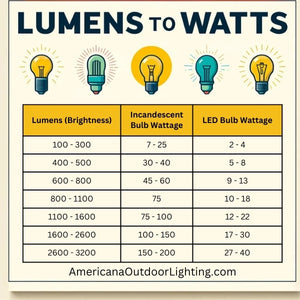When it comes to installing outdoor landscape lighting, understanding how to select the appropriate LED bulb is crucial, particularly when considering lumens and watts.
Whereas wattage used to guide us in selecting the brightness of traditional incandescent bulbs, we now look to lumens to gauge the brightness offered by modern LED technology. This guide will explore the essentials of lumens and watts and provide a detailed conversion chart to aid you in selecting the right LED bulb for your outdoor and indoor spaces.

Understanding the Basics
1. What is a Lumen?
First up, lumens. These units measure how much light a bulb emits. With LED lighting, the rule is simple—the more lumens, the brighter the bulb shines. It's an essential concept that helps us navigate the shift toward more energy-efficient lighting solutions
2. What are Watts?
Watts indicate how much energy a bulb consumes. With traditional bulbs, higher watts meant brighter light. However, with LEDs, less energy (fewer watts) is needed for a higher light output.
3. Luminous Efficacy (Lumens per Watt)
Luminous efficacy is a measure of how efficiently a light source produces visible light, expressed in lumens per watt. LED bulbs typically have an efficacy of 75-110 lumens per watt, making them significantly more efficient than traditional bulbs.
Lumens to Watts Conversion Chart
| Lumens (Brightness) | Incandescent Bulb Wattage | LED Bulb Wattage |
|---|---|---|
| 100 - 300 | 7 - 25 | 2 - 4 |
| 400 - 500 | 30 - 40 | 5 - 8 |
| 600 - 800 | 45 - 60 | 9 - 13 |
| 800 - 1100 | 75 | 10 - 18 |
| 1100 - 1600 | 75 - 100 | 12 - 22 |
| 1600 - 2600 | 100 - 150 | 17 - 30 |
| 2600 - 3200 | 150 - 200 | 27 - 40 |
This conversion chart helps you understand how many lumens are equivalent to traditional wattage ratings. Use this to guide your transition from incandescent or halogen bulbs to energy-efficient LED bulbs.
How to Use the Conversion Chart
The lumens to watts conversion chart above needs a little more context to help you better understand it.
Selecting the Right Bulb
- Identify the wattage of the incandescent bulb you are replacing.
- Use the chart to find the equivalent LED wattage based on desired lumens.
- Consider the installation area—whether it’s for task, ambient, or outdoor lighting:
- Task Lighting: Choose higher lumens for areas needing bright light, such as workspaces.
- Ambient Lighting: Opt for fewer lumens to create a soft, relaxing environment in living areas.
- Outdoor Lighting: Adjust lumens based on the need for security or aesthetic lighting.
Factors to Consider
- Color Temperature: Measured in Kelvin, color temperature affects the color and mood of the light. For instance, a warmer light (lower Kelvin) is often used for cozy, relaxed settings, while cooler light (higher Kelvin) is ideal for task lighting.
- Dimmability: Ensure the LED bulb is compatible with dimmers to adjust light levels according to different needs and times of day.
- Durability: LED light fixtures from Americana Outdoor Lighting are designed to withstand various weather conditions, making them perfect for outdoor use.
Adopting LED lighting by understanding the lumens to watts conversion can dramatically improve your space's brightness, cut down on energy use, and lower your electricity bills. By understanding and utilizing this conversion chart, you can effectively choose LED bulbs that meet your lighting needs while contributing to energy savings.
For more details and expert advice, visit Americana Outdoor Lighting or contact our support team for personalized guidance. Embrace the efficiency of LED lighting and illuminate your space with confidence.


